CONGRUENCE OF QUATERNIONIC SKEW-HERMITIAN MATRICES
advertisement
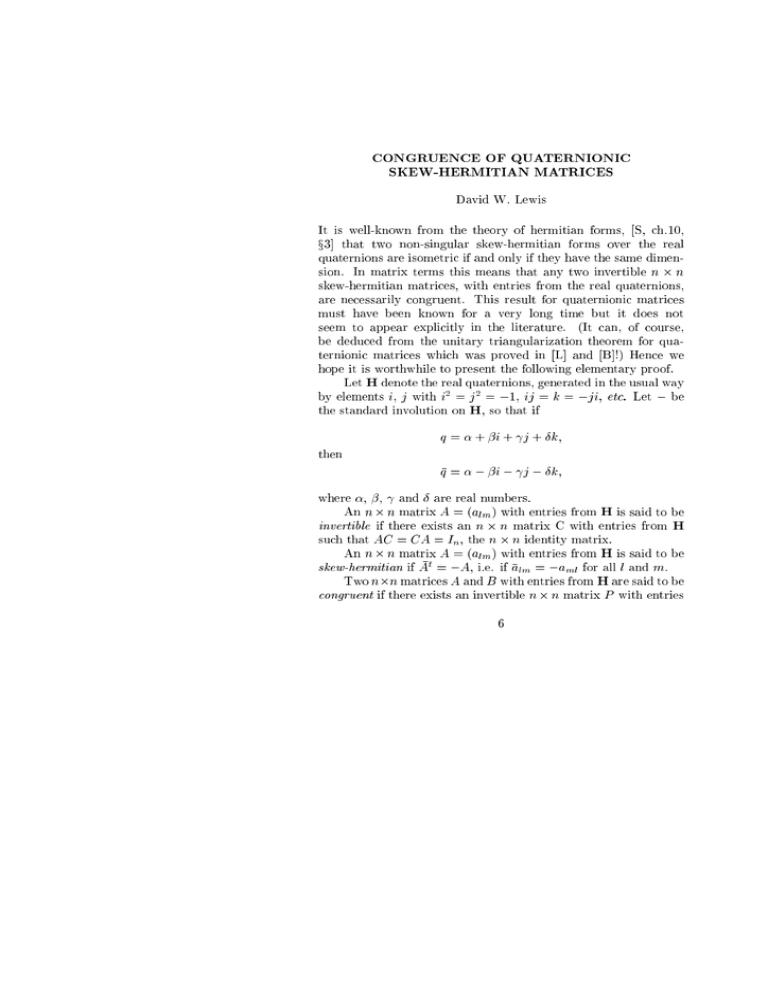
CONGRUENCE OF QUATERNIONIC SKEW-HERMITIAN MATRICES David W. Lewis It is well-known from the theory of hermitian forms, [S, ch.10, x3] that two non-singular skew-hermitian forms over the real quaternions are isometric if and only if they have the same dimension. In matrix terms this means that any two invertible n n skew-hermitian matrices, with entries from the real quaternions, are necessarily congruent. This result for quaternionic matrices must have been known for a very long time but it does not seem to appear explicitly in the literature. (It can, of course, be deduced from the unitary triangularization theorem for quaternionic matrices which was proved in [L] and [B]!) Hence we hope it is worthwhile to present the following elementary proof. Let H denote the real quaternions, generated in the usual way by elements i, j with i2 = j 2 = 1, ij = k = ji, etc. Let be the standard involution on H, so that if then q = + i + j + k; q = i j k; where , , and are real numbers. An n n matrix A = (alm ) with entries from H is said to be invertible if there exists an n n matrix C with entries from H such that AC = CA = In , the n n identity matrix. An n n matrix A = (alm ) with entries from H is said to be skew-hermitian if At = A, i.e. if alm = aml for all l and m. Two nn matrices A and B with entries from H are said to be congruent if there exists an invertible n n matrix P with entries 6 Quaternionic skew-hermitian matrices 7 from H such that P t AP = B . (Congruence is an equivalence relation on tthet set of all n n skew-hermitian matrices. Note that (PQ)t = Q P for any n n matrices P and Q.) Theorem Any two invertible n n skew-hermitian matrices with entries from H are congruent. Proof: It suces to show that any invertible skew-hermitian n n matrix A is congruent to iIn , the diagonal matrix with i in each diagonal place. We will prove this statement by induction on n. Let n = 1 and A = (a) be skew-hermitian, so that a = i + j + k for some , and in R, not all zero. We seek z 2 H such that a = ziz . We will show that it is always possible to nd z 2 H of the form z = ri + sj + tk, where r, s, t are real numbers, for which a = ziz . Since ziz = (r2 s2 t2 )i + 2rsj + 2rtk; we have equations r2 s2 t2 = 2rs = 2rt = : Equating norms on each side of the equality a = ziz yields another equation: (r2 + s2 + t2 )2 = 2 + 2 + 2 : Taking the positive square root of this equation and adding the rst equation above, we see that p p 2r2 = + ( 2 + 2 + 2 ): Now + ( 2 + 2 + 2 ) 0 and equals zero only if = = 0, and p < 0. If = = 0 and < 0, we choose r = t = 0, s = ( ). Otherwise, we can choose positive r satisfying the 8 IMS Bulletin 39, 1997 equation above for r2 and let s = =2r, t = =2r. Either way we obtain z such that a = ziz . This proves the theorem for n = 1. Now assume that the theorem is true for all (n 1) (n 1) skew-hermitian matrices and let A be an invertible n n skewhermitian matrix. Without loss of generality we can assume that the top left-hand corner entry a11 6= 0. (It is an easy exercise to verify that if vt Av = 0 for all column vectors v 2 Hn , then vt Aw = 0 for all v; w 2 Hn. This implies that A = 0. Hence there exists v 2 Hn with vt Av 6= 0. Letting v be the rst column of an invertible matrix P , we can replace A by P t AP which has non-zero top left-hand corner entry.) Choose w 2 H such that waw = i. (Put a = a11 in the n = 1 case above and then take w = z 1 .) Write t a L 11 A= ; L N where L is an (n 1) 1 matrix, and N an (n 1) (n 1) skew-hermitian matrix. Let 1 t P = w a11 L : 0 In 1 Then we nd that t i 0 P AP = 0 B ; with B = N + La111Lt being an invertible (n 1) (n 1) skewhermitian matrix. (Note that B is invertible since A and P are invertible.) By the inductive assumption there is an invertible (n 1) (n 1) matrix Q with Qt BQ = iIn 1 . The n n matrix R = 10 Q0 gives the desired result that Rt P t APR = iIn . Quaternionic skew-hermitian matrices 9 References [B] J. L. Brenner, Matrices of quaternions, Pacic J. Math. 1 (1951), 329335. [L] H. C. Lee, Eigenvalues and canonical forms for matrices with quaternion coecients, Proc. Royal Irish Academy, Section A, 52 (1949), 253-260. [S] W. Scharlau, Quadratic and Hermitian Forms. Grundlehren der math. Wissenschaften 270. Springer-Verlag: Berlin-Heidelberg-New York, 1985. D. W. Lewis Department of Mathematics, University College Dublin, Beleld, Dublin 4, Ireland. email: dwlewis@ollamh.ucd.ie
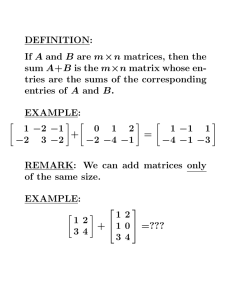

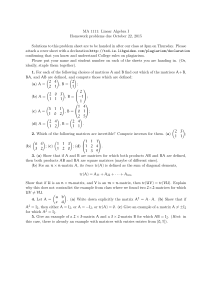
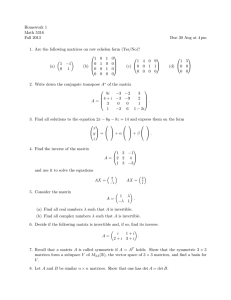

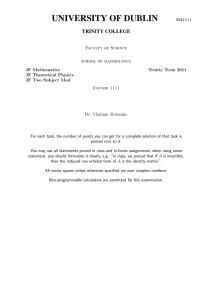
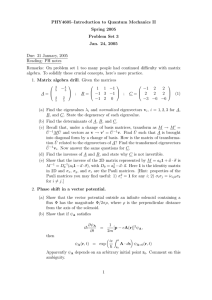
![Quiz #2 & Solutions Math 304 February 12, 2003 1. [10 points] Let](http://s2.studylib.net/store/data/010555391_1-eab6212264cdd44f54c9d1f524071fa5-300x300.png)
